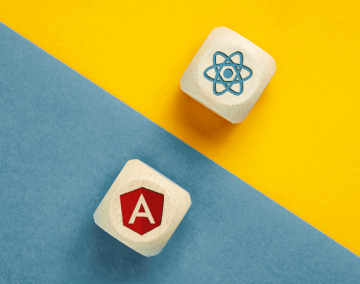Before developing an app, a frontend developer must choose an optimal framework. Both Vue and React are open-source JavaScript toolkit systems to build complex user interfaces. Read our complete comparison and decide for yourself which suits you better.
Table of Contents
What is Vue?
Vue, labeled as a „progressive framework” by its designer Evan You, had its first public appearance in 2014. Originally only used in China, this popular JavaScript framework is now used worldwide to create intuitive user interfaces and Single Page Applications (SPAs).
Vue supports two-way binding and uses a virtual DOM. The key reason for this framework’s popularity is its progressive design, allowing developers to move existing projects constantly. This may be accomplished by shifting each feature individually.
Vue is a community-driven open-source project that is constantly improved and maintained. BuzzFeed, Grammarly, Dribbble, Zoom, BMW, and Nintendo are a few well-known brands affiliated with Vue.
What is React?
React is a JavaScript library used in web development for interactive components on websites and user interfaces. Technically, it is not a framework. While working at Facebook, React was created by Jordan Walke and is now used to build SPAs and mobile apps.
Since it uses components like isolated chunks of code that may be utilized to construct more complicated logic and user interfaces, React provides a lot of flexibility. It also interacts with HTML documents via a virtual DOM, but all elements are represented as JS objects.
React is used by major companies and brands, such as Facebook, Instagram, Whatsapp, Atlassian, Airbnb, PayPal, Dropbox, Netflix, and Uber.

You might also be interested in this article:
7 Famous Applications Built with Node.js
React and Vue comparison
Vue vs. React: Popularity
React has a large community, translating to more tutorials, online courses, publications, and nearly four times more Stackoverflow queries. A larger community also implies a larger ecosystem of third-party libraries, tools, and extensions. All major integrated development environments back it up. Facebook created and maintains the library, ensuring its long-term support.
Although Vue has a lesser market share, its user base has increased. It doesn’t have as many resources, packages, or third-party libraries as React (many have no English localization). Vue is supported by all major IDEs but not as extensively as React.
Vue vs. React: Documentation
React documentation covers the fundamentals of React programming and some progressive ideas. However, it does not provide a comprehensive understanding of the React ecosystem.
While React’s documentation has improved year after year, Vue’s documentation is still recognized as one of the best in the industry. It’s user-friendly for beginners, and it even contains several free tutorials that explain how the framework’s main ideas function. Every developer who wants to create a Vue-based project should read the framework’s documentation and grasp the fundamental concepts.
Vue vs. React: Ecosystem
For routing and state management, React relies on other solutions like Flux/Redux (state refers to data shared between all UI components). These frameworks make debugging easier by providing a single mechanism to change the state. Because Facebook delegated the management of react-redux and react-router to the community, the ecosystem has become increasingly fractured.
Vue has a smaller number of associated libraries. However, Vue has features that need a library in React, such as props check. Vue’s key frameworks, such as Vuex and Vue-router, are maintained and supported by the Vue team.
Vue vs. React: Mobile development
With React Native, you can reuse up to 99 percent of your JS code between Android and iOS. As an outcome, a cross-platform app that appears and functions like a native iOS/Android app has been created. You can make widgets that are 100% native and have complete control over their appearance. The presentation layer is treated as a pure state output by the React Native framework. This makes it simple to develop iOS/Android companion applications with a natural appearance.
Despite being behind React, Vue provides some mobile development alternatives, like NativeScript, Capacitor, and Vue Native. However, none of these are as famous as Facebook’s React Native solution for mobile development.
Vue vs. React: Scalability
React employs JSX, a technique for embedding HTML into JavaScript code. It may take a little longer to get used to, but in the end, this method results in more concise code and improved JavaScript performance.
Apart from JavaScript, Vue lets you use HTML and CSS in their original form entirely freely. This makes the framework easier to grasp for newcomers who often begin their careers by studying the fundamentals of web programming.
Vue vs. React: Performance
Vue and React architectures are similar (both employ virtual DOM), and their sizes are very close. Vue has good performance; file sizes are slightly smaller than React. This might make Vue a little quicker, but not as much as the gap between React/Vue and other frameworks like Angular, which is roughly 500 kb.
Vue vs. React: State management
For React apps, state management is crucial. Several frameworks, such as Redux, may assist you in handling large states. They provide a single method for changing the state, making debugging easier. The built-in context API for state management has been available since the introduction of React 16.3 version. It eliminates many of the previous issues of controlling the state when combined with the newly added webhooks. Still, one of React’s best practices is to use Redux. It’s a well-made and well-documented library that we utilize on most significant projects, where the application state often changes.
In Vue, a local state is unnecessary. The data attribute of a Vue object allows you to change data. However, you’ll need an additional library for state management in more significant web projects (for example, Vuex). The Composition API in Vue’s pre-alpha version 3 is comparable to React’s hooks in several ways. It can make it easier to deal with complicated components in bigger web apps that different developers have built. Its key advantage is that logic may be reused more easily throughout various features.
Vue vs. React: HTML templating vs JSX
React makes use of JSX, a JavaScript-based framework that expresses both HTML and CSS. This enables you to create self-contained interface components that include rendering instructions.
With Single File Components and separate blocks for HTML templates, styles, and JS, Vue takes a more conventional approach. Any front-end developer will recognize this separation of concerns, making the framework simple to understand. Vue templates may be made out of any good HTML, allowing you to move your project to Vue progressively.
Vue vs. React: Server-Side Rendering (SSR)
With built-in SSR features and a clear tutorial right in the docs, Vue is a step ahead of React. React requires third-party libraries such as Next.js to render pages on the server.
Which to choose: Vue or React?
Each project has unique requirements and features, so choosing a framework might be difficult. Each toolkit system has its own set of pros and cons. For example, Vue is smaller and quicker than other toolkits, while React provides more flexibility. It’s also easier to test, more suitable for mobile app development, and provides more information in case of a problem.
At fireup.pro, we prefer to choose React over Vue for frontend development. We are convinced that React enables us to create great interactive user interfaces quickly adapted to mobile with popular React Native. React is non-opinionated and can work alongside several technologies executing back-end, too. React functions as a dynamic ecosystem of tools that can be used in various use cases, such as web app creation, mobile app development, or desktop app development.
Want to make an app? Contact us, and we will make it happen.
